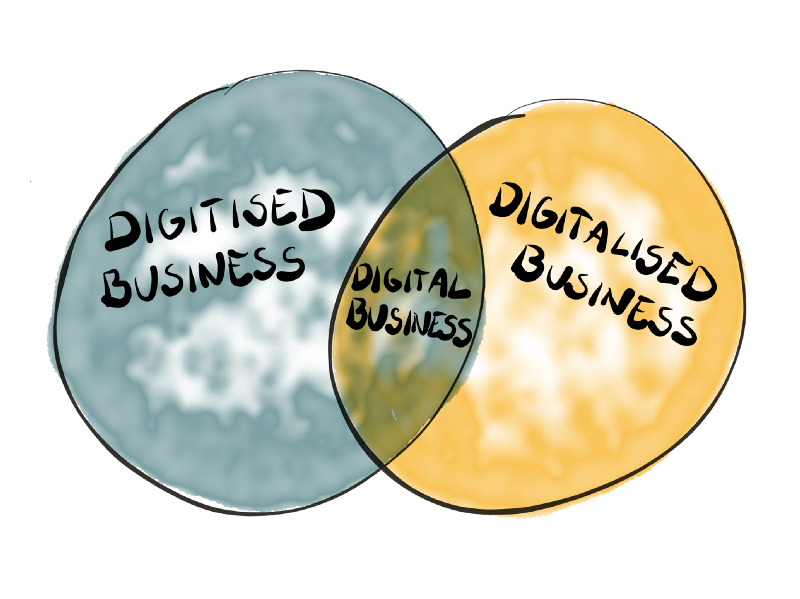The transformational power of two letters.
Digitisation and digitalisation are often used as synonyms. But a truly digital business is both digitised and digitalised.
We often use digitisation and digitalisation as synonyms. We should not. Not because “to digitalise” may — in some situations — mean something entirely different. Digitise and digitalise refer to distinct stages in an organisation’s journey.

Sounds like a rant of grammar police? Perhaps. However, after over 20 years of living in the digital economy and with digital businesses, we have learned that digital could mean both technology (digital technology) and business (digital business). Time to ensure we bring some clarity to our language.
I am not the first one to push for the correct use of the two terms. Others have analysed this topic too: from encyclopaedic entries, through opinion pieces, to corporate news articles.
When we talk about digitisation, we talk about processes focusing on data, converting documents, images, as well as other objects into an electronic format that can be processed by computers. The digitisation trend started in XX century, with organisations moving away from paper, to information systems. These businesses called themselves digital. Digitisation enabled entities around the world to use the power of algorithms and digital technologies to scale their operations, improve service quality, and more. In essence, digitisation helped automate theses organisations.
Digitalisation, in turn, is a way of thinking. It drives how organisations behave and operate in the world. Supported by digitisation (but not requiring it!), digitalisation is an approach to running a business. It focuses on using digital technologies to reimagine products and services, create new business models, and find new ways of generating revenue. It is all about creating opportunities that were unimaginable before: the “new new”. While it is not yet a commonly accepted understanding of the term, it is increasingly and more and more consistently used by large organisations. The distinction between the two words is highlighted more and more.
Digital business is created by both digitisation and digitalisation.

Digital business is both digitised and digitalised
There are three main areas where differences between digitisation and digitalisation are stark in organisations: purpose, focus, and relationship with future.
Purpose
Digitisation helps increase the efficiency of organisations — scale up, avoid human-generated mistakes. It helps grow productivity — the same team size can achieve more. Digitised businesses — compared to non-digitised, or poorly digitised, businesses — are better at addressing problems: problems of scale, human errors, issues with human productivity. In essence, they are problem driven (and good at solving problems).
Digitalisation helps organisations identify entirely new, previously-unknown, streams of revenue. Products and services never possible before can now be offered, increasing organisational revenue resilience. The core purpose of digitalised organisations is not to increase scale, quality or efficiency anymore. They understand that currently-successful business initiatives do not guarantee future success. Thus, digitalised businesses are opportunity-seeking (and good at finding and benefiting from them).
Focus
Digitisation helps organisations automate processes and transactions. It is often introduced to enable industrialisation of operations, mass scale of products and services delivered. Digitised businesses — compared to those that are not fully digitised yet — can easily increase output numbers of the widgets (products or services) they produce.
Digitalisation, in turn, allows businesses to focus on understanding customers and their life events deeply. Through such better understanding, it enables organisations to derive utterly new business models, keeping customers, and their jobs to be done, in the very centre. Digitalised businesses are focused on mass personalisation.
Relationship with future
Properly digitised businesses are excellent at understanding their environment: the now. They can analyse the past, and often use their findings to predict the future. While in the short term such approach may work very well, in the long term it may lead to tragic consequences. Digitised businesses are often very reactive when it comes to their relationship with future.
Digitalisation allows businesses to shift their attention toward the unknown: the future. Digitalised organisations live by the famous motto: “we cannot predict the future, but we can invent it”. Often, it means that digitalised businesses learn from the past, but then they focus on the continuous reinvention of themselves. Their relationship with future is proactive.

Digitalising an already digitised business will dramatically change its mindset
While I started this article with a focus on the distinction between two terms often used as synonyms, the nature of the argument is much deeper than that. The difference between digitised and digitalised businesses is so significant that a misunderstanding may lead to dire consequences. Choosing one direction — digitisation or digitalisation — will have a profound impact on the way a company operates.
Interested in this topic? Listen to The Digital Week | Are you digitising or digitalising?



